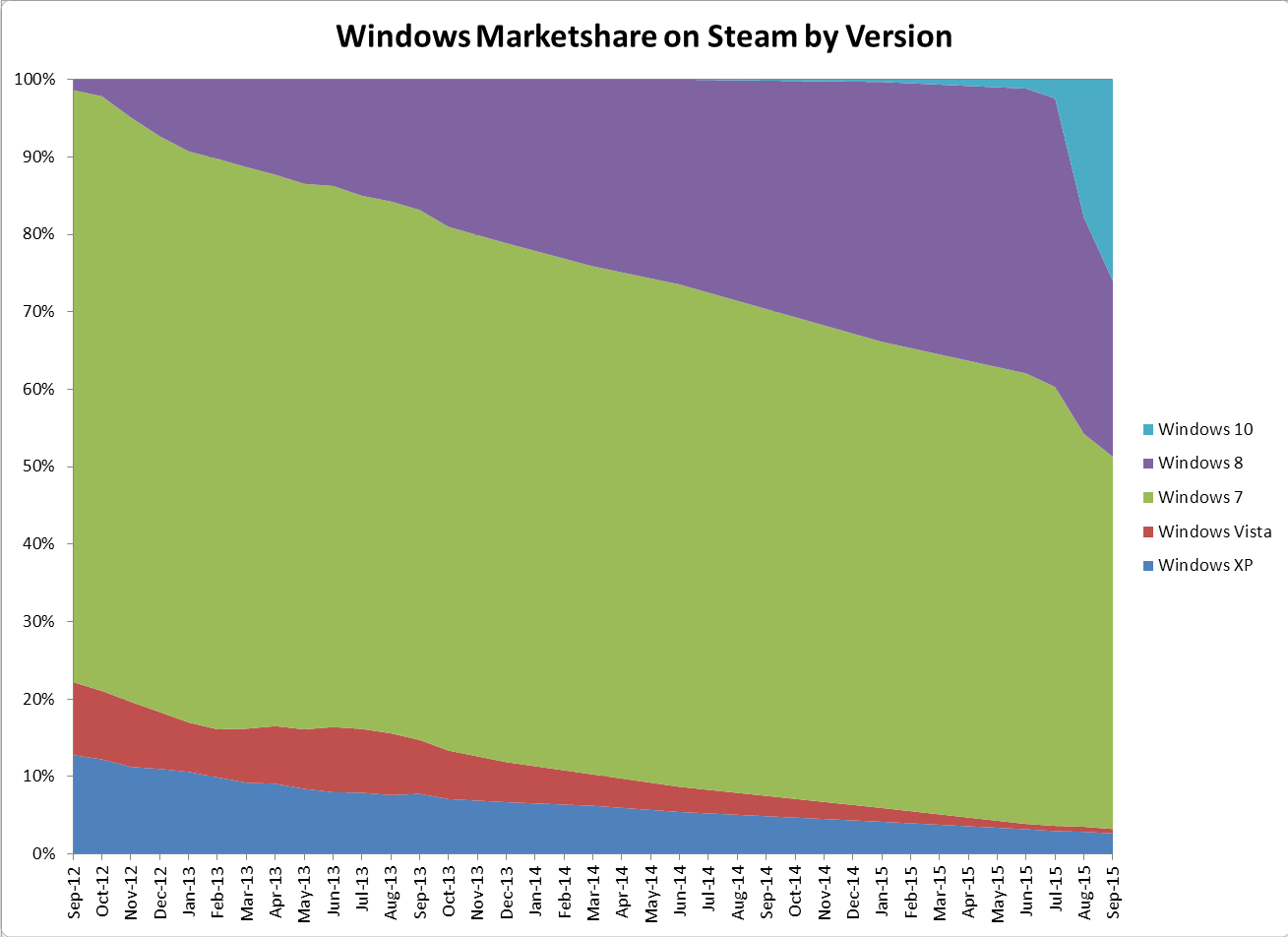I've been taking notes on the uptake of operating systems, as well as CPU, RAM, and GPU trends, on Steam via their hardware survey off and on for the past 5 years. It's interesting information, giving a glimpse of what the typical PC gamer has hardware-wise, as well as giving insights into the hardware trends of a market that typically moves faster than end-user computers as a whole. I've particularly been noting the Windows trends over the past 5 years, excluding OS X, to get a picture more specific to Windows users.
Naturally, then, I took an interest in Windows 10 uptake. It's no secret that Windows 8 hasn't overtaken Windows 7 in general, and it hasn't on Steam either. Of Windows Steam users in June 2015 - the last full month prior to the release of Windows 10 - 58.14% ran Windows 7, whereas 36.75% ran Windows 8 (including Windows 8.1). The remainder were primarily on XP, with less than 1% on Vista. Would Windows 10 take Steam by storm, with over 90% of the userbase eligible for a free upgrade, or would consumers be skeptical of it like Windows 8?
The answer so far has been somewhere in between. Almost 26% of Steam users were running Windows 10 by the end of September - a substantial share in only two months. But those users has disproportionately been running Windows 8 previously. The below chart shows share by Windows version since one month before the availability of Windows 8.

The Windows 10 spike is significant, for sure. Windows 8 got off to a much slower start. Windows 10 had 17.77% of the Windows market on Steam by one month; it took Windows 8 twelve months to get that. The 25.98% that Windows 10 had after two months took about 20 months for Windows 8 (that time period is one where I missed a few months, and thus have to interpolate).
But even from the chart, we can see that it's Windows 8 that Windows 10 is mainly gaining from. Which versions have lost the most share since June?
It's also interesting to look at July through September, since Windows 10 was only out for a few days in July, and Windows 8 was still gaining through July (and Windows 7 was not):
Regardless, the trend is clear - far more Windows 8 users have jumped to 10 than have Windows 7 users. Windows 8 users were more than twice as likely to upgrade to Windows 10. This supports the pre-release prediction that the difficult thing for Microsoft would be convincing Windows 7 users to upgrade.
It's also noteworthy that the rate of decrease for Vista is in fact higher than for 7, despite Vista not having a free upgrade. Looking farther back in my data, however, this is not as much of a surprise. Between June 2014 and June 2015, Vista lost over 79% of its Windows market share on Steam, going from 3.25% to 0.68%. This compared with a 41% decline for XP over the same period. So Vista's market share has been eroding quickly for over a year, free upgrade or not. That it's quicker than 7's decrease is more a testament to Windows 7 users not jumping to 10 in droves, than it is to Vista users seeing 10 and buying an upgrade.
XP, meanwhile, continues to have staying power with its remaining userbase. This isn't really surprising - XP didn't have a free upgrade to 10, so I wouldn't have expected its rate of decrease to be substantially higher than before.
The real question for Microsoft will be, can they keep the adoption moving? Windows 10 gained over 15 percentage points in August (2% to 17%), but only 8 percentage points in September (17% and change to 25%, just below 26%). September likely is the last month where Windows 7 will outnumber 8 and 10 combined, but 7 still has far too much market share to ignore. If Microsoft can keep convincing 15% of Windows 7 users to jump every 2 months, perhaps with the DirectX 12 carrot, Windows 10 will have a plurality and then a majority before long. But if the adoption rate slides every month, Windows 7 will have a plurality for a good while yet.
October will provide more interesting data; it will be especially interesting to see if Windows 10's September adoption rate can be maintained, or if it will continue to fall each month.
Return to Blog Index